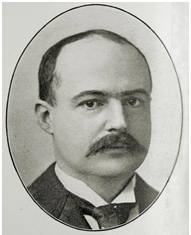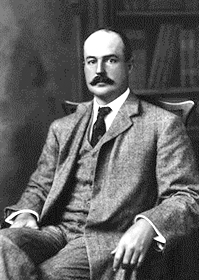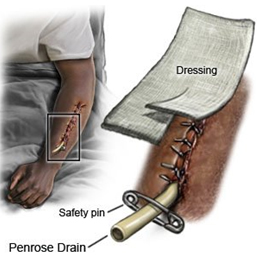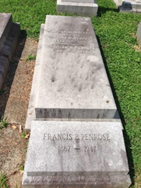|
||||||||||||||||||||||||||||||||||||
| [
Contents
] [ INDEX ]
|
||||||||||||||||||||||||||||||||||||
|
Page 62 |
||||||||||||||||||||||||||||||||||||
|
History of medicine Charles Bingham Penrose – a vision for the future Srđan Petković (1), Goran Krstić (2), Milan Jovanović (1,3) |
||||||||||||||||||||||||||||||||||||
|
|
||||||||||||||||||||||||||||||||||||
| Download in pdf format | Summary: Charles
Bingham Penrose (1862–1925) was a renowned American surgeon and
physicist who secured his place in the history of surgery with the
invention of a drain named after him. Penrose attended Harvard
College, where he graduated at the age of 19 with highest honors in
physics. At 22, he earned his Doctor of Medicine degree from the
University of Pennsylvania. Following his graduation, he worked as
an ambulatory surgeon, participated in various research projects,
and ran a medical practice specializing in gynecology. In 1887, he
founded the first hospital in Philadelphia dedicated exclusively to
gynecological issues. For his contributions to this field, he was
awarded the title of Professor of Gynecology at the University of
Pennsylvania in 1893. In the late 19th century, Penrose focused
primarily on surgical drainage and the education of surgeons in this
field, encouraging them to use this procedure more frequently. He
described a rubber drain used for abdominal cavity drainage, which
remained in use until the mid-20th century. This drain came to be
known as the Penrose drain. Penrose contracted tuberculosis at a
young age, and due to the advanced form of the disease, he had to
withdraw from medical practice at the age of 38. He was married and
a father to three children. Charles Bingham Penrose passed away on
February 28, 1925, at the age of 64, while on a train near
Washington, D.C.. Key words: Charles Bingham Penrose – Surgeon, Drain |
|||||||||||||||||||||||||||||||||||
|
INTRODUCTION In the history of medicine, there have been
widely used therapies that may seem almost laughable in light of
modern knowledge about physiology and medical practice, yet they
play an important role in the education of physicians. The past
provides a lesson for the present and a direction for the future.
However, we must persistently engage in critical examination of the
past. We still do not have all the answers, but we can affirm that
answers exist. One goal remains always important – believe in
yourself and your ideas. And that is what defines exceptional
people. Picture 1. Charles Bingham Penrose
Charles Bingham Penrose – Surgeon, Physicist, Naturalist,
Adventurer. Charles Bingham Penrose was born in Philadelphia on
February 1, 1862. Charles’s father, Richard Allen Fullerton Penrose
Sr., was a physician and a professor of obstetrics at the University
of Pennsylvania, while Charles’s mother, Sarah Hanna Boies Penrose,
hailed from Maryland and was adopted by a wealthy Boston merchant.
Shortly after marrying Richard, Sarah withdrew from high society and
focused on educating her seven sons. Richard Allen Fullerton Penrose
came from a prestigious Philadelphia family. One brother was a
United States senator, and another was president of the National
Academy of Sciences [1,2]. Picture 2. Penrose as a Professor of
Gynecology at the University of Pennsylvania
As a physician, Penrose ran a medical practice specializing in
gynecology. This led him to establish the Gynecean Hospital in 1887,
the first medical institution in Philadelphia dedicated exclusively
to gynecological issues. After contracting tuberculosis in 1891,
Penrose temporarily left his medical practice and moved to Wyoming
for recovery. There, he fully committed to physical activity: in the
mornings, he worked with a pickaxe and shovel, and in the
afternoons, he rode horses. By early the following year, his health
had significantly improved. Returning to Philadelphia in 1893, he
was appointed Professor of Gynecology at the University of
Pennsylvania. Colleagues regarded Penrose as a skilled and competent
surgeon [1,6]. Picture 3. Principle of Operation of the
Penrose Drain
An interesting fact is that the first rubber drain designed by
Penrose was made from a condom with its tip cut off. Another fact is
that the Penrose drain became the dominant method of surgical
drainage until the introduction of the Jackson-Pratt (suction) drain
in the 1950s [8]. Picture 4. The Family Tomb of Charles
Bingham Penrose
He was buried at Laurel Hill Cemetery in Philadelphia. The
majority of his fortune was left to his children, and $100,000 was
bequeathed to the nurse who cared for him until his death [1]. REFERENCE:
|
||||||||||||||||||||||||||||||||||||
|
|
||||||||||||||||||||||||||||||||||||
| [
Contents
] [ INDEX ]
|
||||||||||||||||||||||||||||||||||||
|
||||||||||||||||||||||||||||||||||||




